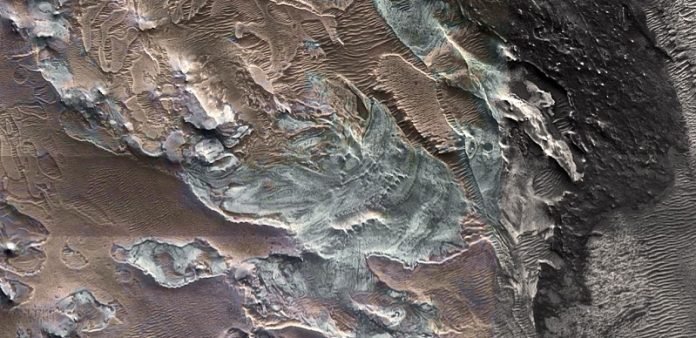
If there is still water ice preserved at shallow depths at a low latitude on Mars, there would be implications for science and human exploration.
A group of scientists has made a groundbreaking discovery that could change our understanding of the recent history of Mars.
At the 54th Lunar and Planetary Science Conference held in The Woodlands, Texas, they revealed the existence of a relict glacier near Mars’ equator.
The glacier was found in Eastern Noctis Labyrinthus at coordinates 7° 33′ S, 93° 14′ W and is significant because it suggests that Mars had more water on its surface in recent times than previously believed.
The discovery was made by examining a light-toned deposit (LTD) in the region. While LTDs typically consist of light-colored sulfate salts, this deposit had many of the features of a glacier, such as crevasse fields and moraine bands.
The glacier is thought to be around 6 kilometers long and up to 4 kilometers wide, with a surface elevation ranging from +1.3 to +1.7 kilometers.
Dr. Pascal Lee, a planetary scientist with the SETI Institute and the Mars Institute, led the study and explained that the deposit was not ice, but rather a salt deposit with the detailed morphologic features of a glacier.
The most likely explanation for this is that salt formed on top of a glacier while preserving the shape of the ice below, down to details like crevasse fields and moraine bands.
The presence of volcanic materials in the region indicates that sulfate salts may have formed and preserved a glacier’s imprint underneath.
When freshly erupted pyroclastic materials (mixtures of volcanic ash, pumice, and hot lava blocks) come into contact with water ice, sulfate salts like the ones commonly found on Mars may form and build up into a hardened, crusty salt layer.
Over time, with erosion removing the volcanic materials, a crusty layer of sulfates mirroring the glacier ice underneath became exposed.
The glacier’s fine-scale features, its associated sulfate salts deposit, and the overlying volcanic materials are all very sparsely cratered by impacts and must be geologically young, likely Amazonian in age, the latest geologic period that includes modern Mars.
This suggests that Mars experienced surface ice in recent times, even near the equator.
While it remains to be seen whether water ice might still be preserved underneath the light-toned deposit or if it has disappeared entirely, the discovery has significant implications for future human exploration of Mars.
“The desire to land humans at a location where they might be able to extract water ice from the ground has been pushing mission planners to consider higher latitude sites. But the latter environments are typically colder and more challenging for humans and robots.
If there were equatorial locations where ice might be found at shallow depth, then we’d have the best of both environments: warmer conditions for human exploration and still access to ice,” said Dr. Lee.
However, Lee cautions that more work needs to be done to determine if, and how much, water ice might actually be present in this relict glacier, and whether other light-toned deposits might also have, or have had, ice-rich substrates.
In conclusion, this discovery is significant as it suggests that Mars had more water on its surface in recent times than previously believed.
The existence of a relict glacier near Mars’ equator could have significant implications for future human exploration, as it raises the possibility that ice may still exist at shallow depths in the area.
While more work needs to be done to determine the extent of the water ice, this discovery is a significant step forward in our understanding of Mars’ history and potential for future exploration.
Source: SETI Institute.



